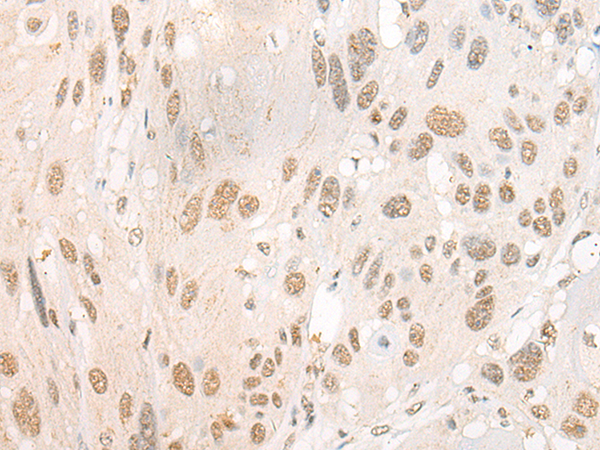

| WB | 咨询技术 | Human,Mouse,Rat |
| IF | 咨询技术 | Human,Mouse,Rat |
| IHC | 1/20-1/100 | Human,Mouse,Rat |
| ICC | 技术咨询 | Human,Mouse,Rat |
| FCM | 咨询技术 | Human,Mouse,Rat |
| Elisa | 1/5000-1/10000 | Human,Mouse,Rat |
| Aliases | TSG10; VPS23 |
| Host/Isotype | Rabbit IgG |
| Antibody Type | Primary antibody |
| Storage | Store at 4°C short term. Aliquot and store at -20°C long term. Avoid freeze/thaw cycles. |
| Species Reactivity | Human, Mouse, Rat |
| Immunogen | Fusion protein of human TSG101 |
| Formulation | Purified antibody in PBS with 0.05% sodium azide and 50% glycerol. |
+ +
以下是关于TSG101抗体的3篇代表性文献摘要信息:
---
1. **文献名称**:*HIV-1 and Ebola Virus Encode Small Peptide Motifs that Recruit Tsg101 for Particle Release*
**作者**:Garrus JE, et al.
**摘要**:该研究首次报道TSG101蛋白在HIV-1病毒出芽中的关键作用,通过使用TSG101抗体进行免疫共沉淀实验,揭示了HIV-1 Gag蛋白与TSG101的直接相互作用,并证明抗体阻断该通路可抑制病毒释放。
---
2. **文献名称**:*Downregulation of TSG101 by siRNA inhibits breast cancer cell proliferation and tumor growth in vivo*
**作者**:Li L, et al.
**摘要**:研究通过Western blot和免疫组化技术(使用TSG101抗体)发现,TSG101在乳腺癌组织中高表达,并通过siRNA敲低TSG101后显著抑制肿瘤细胞增殖,表明其作为潜在治疗靶点的价值。
---
3. **文献名称**:*ESCRT-III recognition by VPS4 ATPases*
**作者**:Sachse M, et al.
**摘要**:该文献利用TSG101抗体进行免疫荧光定位和蛋白质相互作用分析,阐明了TSG101在ESCRT-III复合体与VPS4 ATP酶之间的桥梁作用,揭示了其在细胞分裂和膜重塑中的分子机制。
---
如需具体引用格式或更多文献,可进一步补充研究关键词或应用场景。
The TSG101 (Tumor Susceptibility Gene 101) antibody is a widely used tool in biomedical research to detect and study the TSG101 protein, a critical component of the ESCRT-I (Endosomal Sorting Complex Required for Transport-I) machinery. TSG101. first identified in 1996 through its role in tumor suppression, plays essential roles in cellular processes such as endosomal sorting, vesicle trafficking, viral budding, and cytokinesis. It facilitates the ubiquitin-dependent sorting of cargo proteins into multivesicular bodies (MVBs) and participates in membrane remodeling events. Dysregulation of TSG101 has been linked to cancer, neurodegenerative diseases, and viral pathogenesis, notably HIV-1 release.
The TSG101 antibody is pivotal in experiments like Western blotting, immunoprecipitation, and immunofluorescence to analyze protein expression, localization, and interactions. It helps investigate TSG101's dual role as both a potential tumor suppressor (via genomic stability maintenance) and an oncogenic driver (when overexpressed or mutated). Commercial TSG101 antibodies are typically developed in hosts like mice or rabbits, targeting specific epitopes (e.g., N-terminal regions). Validation in knock-out models ensures specificity, as non-specific binding can occur due to homologous ESCRT proteins. Its applications span cancer research, virology, and studies of ESCRT-related pathways, making it indispensable for understanding intracellular trafficking and disease mechanisms.
×